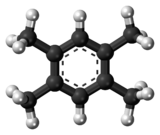Chemistry:Durene

| |

| |
| Names | |
|---|---|
| Preferred IUPAC name
1,2,4,5-Tetramethylbenzene | |
| Other names
Durol
| |
| Identifiers | |
3D model (JSmol)
|
|
| ChEBI | |
| ChemSpider | |
| KEGG | |
PubChem CID
|
|
| UNII | |
| |
| |
| Properties | |
| C10H14 | |
| Molar mass | 134.21816 |
| Density | 0.868 g/cm3 |
| Melting point | 79.2 °C (174.6 °F; 352.3 K) |
| Boiling point | 192 °C (378 °F; 465 K) at 760mmHg |
| -101.2·10−6 cm3/mol | |
| Hazards | |
| Main hazards | Flammable |
| Flash point | 73.9 °C (165.0 °F; 347.0 K) |
Except where otherwise noted, data are given for materials in their standard state (at 25 °C [77 °F], 100 kPa). | |
| Infobox references | |
Durene, or 1,2,4,5-tetramethylbenzene, is an organic compound with the formula C6H2(CH3)4. It is a colourless solid with a sweet odor. The compound is classified as an alkylbenzene. It is one of three isomers of tetramethylbenzene, the other two being prehnitene (1,2,3,4-tetramethylbenzene) and isodurene (1,2,3,5-tetramethylbenzene). Durene has an unusually high melting point (79.2 °C), reflecting its high molecular symmetry.
Production
It is a component of coal tar and was first prepared from pseudocumene in 1870.[1] It is produced by methylation of other methylated benzene compounds such as p-xylene and pseudocumene.[2]
- C6H4(CH3)2 + 2 CH3Cl → C6H2(CH3)4 + 2 HCl
In industry, a mixture of xylenes and trimethylbenzenes is alkylated with methanol. Durene can be separated from its isomers by selective crystallization, exploiting its high melting point.[3] The original synthesis of durene involved a similar reaction starting from toluene.[4]
Durene is a significant byproduct of the production of gasoline from methanol via the "MTG (Methanol to Gasoline) process".[5]
Reactions and uses
It is a relatively easily oxidized benzene derivative, with E1/2 of 2.03 V vs NHE.[6] Its nucleophilicity is comparable to that of phenol.[7] It is readily halogenated on the ring for example. Nitration gives the dinitro derivative, a precursor to duroquinone. In industry, it is the precursor to pyromellitic dianhydride, which is used for manufacturing curing agents, adhesives, coating materials. It is used in the manufacture of some raw materials for engineering plastics (polyimides) and cross-linking agent for alkyd resins.[8] It is also a suitable starting material for the synthesis of hexamethylbenzene.[2]
With a simple proton NMR spectrum comprising two signals due to the 2 aromatic hydrogens (2H) and four methyl groups (12H), durene is used as an internal standard.[9]
Safety
Durene is not a skin irritant nor a skin sensitizer or eye irritant. Durene is only slightly toxic on an acute toxicologic basis and only poses an acute health hazard when ingested in excessive quantities.[10]
References
- ↑ Jannasch, Paul; Fittig, Rudolph (1870). "Ueber das Tetramethylbenzol". Zeitschrift für Chemie 6: 161–162. https://archive.org/stream/zeitschriftfrch22unkngoog#page/n166/mode/1up.
- ↑ 2.0 2.1 Smith, Lee Irvin (1930). "Durene". Organic Syntheses 10: 32. doi:10.15227/orgsyn.010.0032. http://www.orgsyn.org/demo.aspx?prep=CV2P0248.; Collective Volume, 2, pp. 248
- ↑ Griesbaum, Karl; Behr, Arno; Biedenkapp, Dieter; Voges, Heinz-Werner; Garbe, Dorothea; Paetz, Christian; Collin, Gerd; Mayer, Dieter et al. (2002). "Ullmann's Encyclopedia of Industrial Chemistry". Ullmann's Encyclopedia of Industrial Chemistry. Weinheim: Wiley-VCH. doi:10.1002/14356007.a13_227.
- ↑ Ador, E.; Rilliet, A. (1879). "Ueber durch Einwirkung von Chlormethyl auf Benzol in Gegenwart von Aluminiumchlorid erhaltene Kohlenwasserstoffe". Chem. Ber. 12: 329–332. doi:10.1002/cber.18790120191. https://zenodo.org/record/1425188.
- ↑ Packer, John; Kooy, P.; Kirk, C. M.; Wrinkles, Claire. "The Production of Methanol and Gasoline". New Zealand Institute of Chemistry. http://nzic.org.nz/ChemProcesses/energy/7D.pdf.
- ↑ Howell, J. O.; Goncalves, J. M.; Amatore, C.; Klasinc, L.; Wightman, R. M.; Kochi, J. K. (1984). "Electron transfer from aromatic hydrocarbons and their pi-complexes with metals. Comparison of the standard oxidation potentials and vertical ionization potentials". Journal of the American Chemical Society 106 (14): 3968–3976. doi:10.1021/ja00326a014.
- ↑ Griesbaum, Karl; Behr, Arno; Biedenkapp, Dieter; Voges, Heinz-Werner; Garbe, Dorothea; Paetz, Christian; Collin, Gerd; Mayer, Dieter et al. (2002). Ullmann's Encyclopedia of Industrial Chemistry. doi:10.1002/14356007.a13_227. ISBN 3527306730.
- ↑ Röhrscheid, F. (2012). Ullmann's Encyclopedia of Industrial Chemistry. doi:10.1002/14356007.a05_249. ISBN 978-3527306732.
- ↑ e.g. in Petr K. Sazonov, Vasyli A. Ivushkin, Galina A. Artamkina, and Irina P. Beletskaya (2003). "Metal carbonyl anions as model metal-centered nucleophiles in aromatic and vinylic substitution reactions". Arkivoc 10: 323–334. http://www.arkat-usa.org/get-file/19535/.
- ↑ Dennis W. Lynch, Vernon B. Perone, Ronald L. Schuler, William B. Ushry & Trent R. Lewis, Journal Drug and Chemical Toxicology Volume 1, 1978 - Issue 3, Pages 219-230 (2008)
 |

